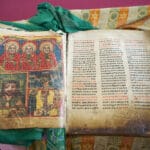“`markdown
Rediscover Six Saints: Eucharistic Revival in Modern Catholicism
A remarkable renewal is underway in the Catholic Church, marked by a surge of interest in the Eucharist and the relics of saints. This movement transcends mere nostalgia; it’s a vibrant expression of the Eucharist’s central importance and the profound connection individuals experience with saints through their relics. This article delves into the reasons behind this growing devotion to Eucharistic saints and their relics, explores how figures like Carlo Acutis are influencing contemporary faith, and examines the significance of these sacred objects in the Church today. From the history and meaning of relic veneration to practical ways of engaging with this tradition, we aim to provide insights and inspire a deeper appreciation for these holy individuals and their connection to the divine. For more on a well-known Eucharistic saint, learn more about St. Anthony of Padua.
Rediscovering Six Saints: A Eucharistic Revival in Modern Catholicism
A wave of renewed devotion to the Eucharist is sweeping through the Catholic Church, evidenced by overflowing attendance at Eucharistic Congresses, heightened reverence for saints deeply connected to Holy Communion, and a burgeoning interest in sacred relics. What lies beneath this powerful spiritual shift? Is it simply a nostalgic return to tradition, or does it represent something more profound in our era of faith and devotion? Let’s explore this fascinating trend of Eucharistic adoration and uncover the significance behind it.
The Allure of Relics: More Than Just Ancient Artifacts
A key element in this Eucharistic revival is the increasing accessibility of saints’ relics. Far from being mere historical artifacts, these objects serve as tangible links to the past, offering a deeply personal connection to the lives of extraordinary individuals who exemplified unwavering faith. Imagine attending a major Eucharistic Congress, surrounded by thousands of fellow believers, and encountering relics – perhaps a fragment of clothing or a bone – that once belonged to a saint. This experience provides a powerful, physical reminder of their holiness, their profound devotion to the Eucharist, and their closeness to God. It bridges the gap of time, allowing us to touch faith made real. This tangible connection ignites deeper faith in many, fostering Eucharistic piety.
Carlo Acutis: A Modern Saint for a Digital Age
Consider Blessed Carlo Acutis, a young man whose fervent love for the Eucharist resonates deeply with today’s digital generation. He meticulously documented Eucharistic miracles, a testament to his faith, utilizing the very technologies familiar to many young people. He not only believed but actively shared his faith in a contemporary manner. His story serves as a beacon, demonstrating how faith can flourish in the modern world. This relatability is essential; his example bridges the timeless devotion to the Eucharist with contemporary life, reflecting Eucharistic spirituality.
Beyond the Famous: Uncovering Lesser-Known Eucharistic Saints
While well-known saints rightfully hold prominent places in our devotion, a wealth of lesser-known individuals also displayed profound devotion to the Holy Eucharist, meriting our attention. Their stories, often less publicized, enrich our understanding of the vast tapestry of faith throughout history. These individuals inspire us with their unique expressions of devotion and offer valuable perspectives on faith lived across different eras and cultures. Exploring their lives expands our connection to the broader narrative of Eucharistic devotion.
Let’s highlight six such saints, each with a distinct story representing different times and places, as examples of profound Christian devotion:
The Power of Technology: Sharing Faith in the Digital Age
Technology plays a significant role in this modern Eucharistic revival. Websites, social media platforms, and even virtual tours of holy sites are making access to Eucharistic devotion more accessible than ever. Individuals worldwide can now engage with the faith and the stories of saints in ways previously unimaginable. However, this enhanced accessibility also raises concerns. Some question whether this ease of access might diminish the reverence traditionally associated with such practices. It’s a complex issue with varying perspectives on faith transmission.
Navigating Challenges: Balancing Tradition and Modernity
This renewed focus on the Eucharist and relics presents certain challenges. Variations in the veneration of relics necessitate a clear theological understanding to ensure respect and prevent misinterpretations. The Catholic Church emphasizes reverence, not worship, of relics, a distinction that must be maintained. Similarly, balancing the traditional reverence for these practices with modern understanding requires thoughtful consideration of relic authenticity. The Church continuously adapts its understanding and practices within the framework of unchanging doctrine.
The Future of Eucharistic Devotion: A Path of Continued Growth
The future of Eucharistic devotion appears promising. The ongoing emphasis on Eucharistic Congresses, the growing interest in the lives of saints, and the increasing accessibility of relics collectively suggest a robust and enduring renewal of faith. However, fostering a deeper understanding of the theology surrounding the Eucharist and the proper veneration of relics is crucial. This requires continuous dialogue between clergy and laity, ensuring shared comprehension and fostering respectful practices for this essential aspect of Catholic faith, thereby supporting Catholic tradition.
A Closer Look at Six Saints
To better understand this renewed devotion, let’s delve into the lives of six saints, each with a unique connection to the Eucharist.
| Saint’s Name | Era | Connection to the Eucharist | Relevance Today |
|---|---|---|---|
| Saint Margaret Mary Alacoque | 17th Century | Profound mystical experiences, including visions of the Sacred Heart of Jesus, emphasizing the Eucharist. | Her devotion to the Sacred Heart continues to inspire Eucharistic adoration and a deeper understanding of Christ’s love. |
| Saint Catherine of Siena | 14th Century | Doctor of the Church known for her intense mystical experiences and deep, personal relationship with Christ in the Eucharist. | Her passionate faith and unwavering dedication to Christ’s presence in the Eucharist serve as a model for all believers. |
| Saint Anthony of Padua | 13th Century | Renowned for his miracles and unwavering faith, he is often associated with the Eucharist and its power. | He serves as a reminder of the power of faith and the miracles associated with the Eucharist in times of need. |
| Saint Thomas Aquinas | 13th Century | A brilliant theologian whose writings profoundly shaped Eucharistic theology and understanding of transubstantiation. | His theological clarity continues to guide the Church’s understanding of the sacrament and its real presence. |
| Saint Edith Stein (St. Teresa Benedicta of the Cross) | 20th Century | Carmelite nun, philosopher, and martyr whose faith profoundly shaped her intellectual pursuits and ultimate sacrifice. | Her intellectual depth combined with unwavering faith in the face of persecution provides a powerful example of living out one’s beliefs. |
| Blessed Carlo Acutis | 20th-21st Century | Modern saint who used his computer skills to document Eucharistic miracles, showcasing his deep love for the Eucharist. | His use of technology to spread the message of the Eucharist resonates with young people and demonstrates the relevance of faith in the digital age. He provides a relatable example of holiness for contemporary youth. |
How to venerate lesser-known Catholic saints’ relics
Key Takeaways:
- The veneration of saints’ relics is a time-honored Catholic practice with roots in scripture and tradition.
- A sound theological understanding is paramount: Relics are venerated not for any inherent power they possess, but as tangible connections to the saints and, ultimately, to God.
- Authenticity is of utmost importance; the Church diligently works to ensure the legitimacy of relics.
- Venerating relics of lesser-known Catholic saints involves prayerful reflection and a focus on the saint’s life, virtues, and witness to the Gospel.
- Modern approaches to relic veneration seek to integrate respect for tradition with contemporary sensibilities and understanding.
The Historical Context of Relic Veneration
From the earliest days of Christianity, the faithful have cherished objects associated with saints. Consider the cloths that touched Paul’s skin in Acts 19:11-12, resulting in miraculous healings. The power came not from the objects themselves, but from God, working through the faith of those who used them. Relics serve as tangible links to the lives of those who lived lives fully devoted to God, offering a point of connection and a focus for prayer.
This tradition continued throughout the centuries, becoming an integral part of Catholic piety. Church leaders recognized the importance of properly understanding and regulating this practice; hence, guidelines were introduced to ensure authenticity and prevent abuses. Even with these safeguards, questions about authenticity remain a necessary element of faithful inquiry. The authentication process often involves meticulous documentation, historical research, and, in some cases, scientific analysis.
Understanding Veneration: Latria vs. Dulia
It’s crucial to understand the distinction between latria and dulia. Latria is the worship exclusively reserved for God. Dulia is the veneration given to saints, recognizing their holiness and their closeness to God. Venerating a relic is not worshipping the object; it’s honoring the saint, and by extension, God, through that connection. This distinction helps avoid misunderstanding and ensures that proper reverence is given where it’s due, enabling spiritual growth. Catechesis on this distinction is essential for promoting a balanced understanding of relic veneration.
How to Venerate Lesser-Known Catholic Saints’ Relics
So, how can you engage with this rich tradition? Here’s how to venerate relics of lesser-known Catholic saints.
1
















